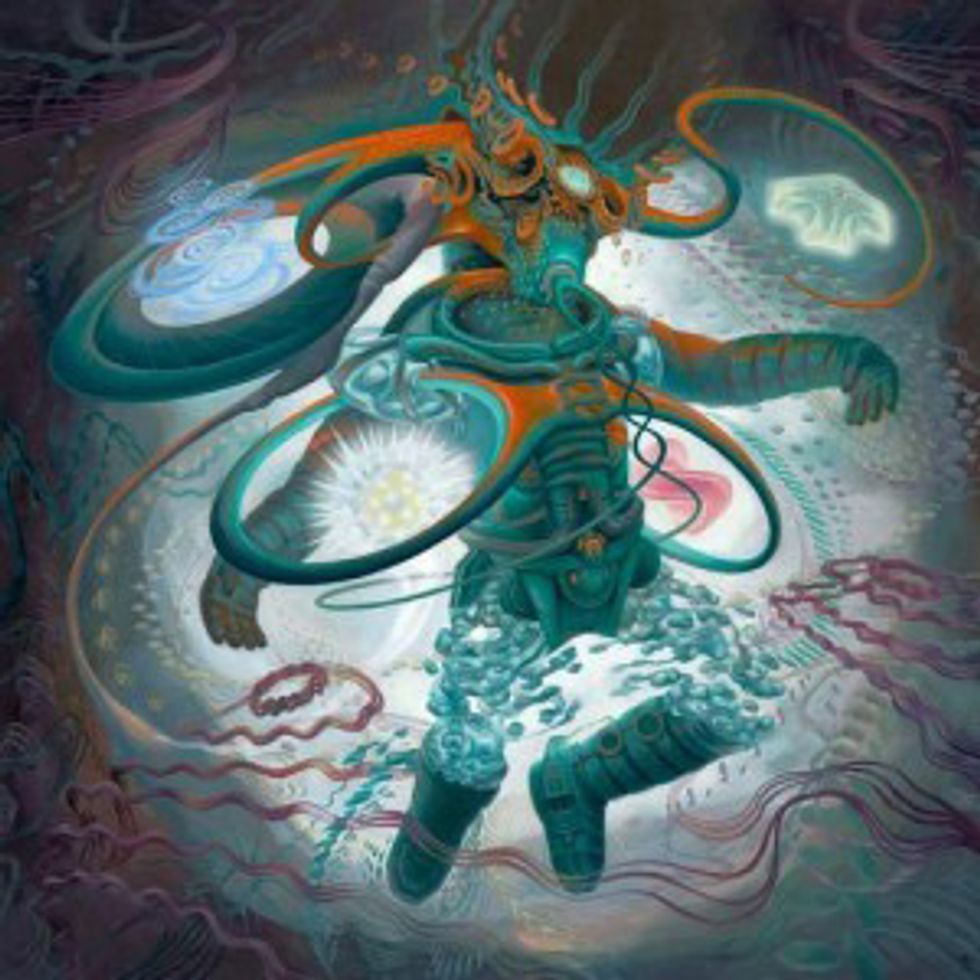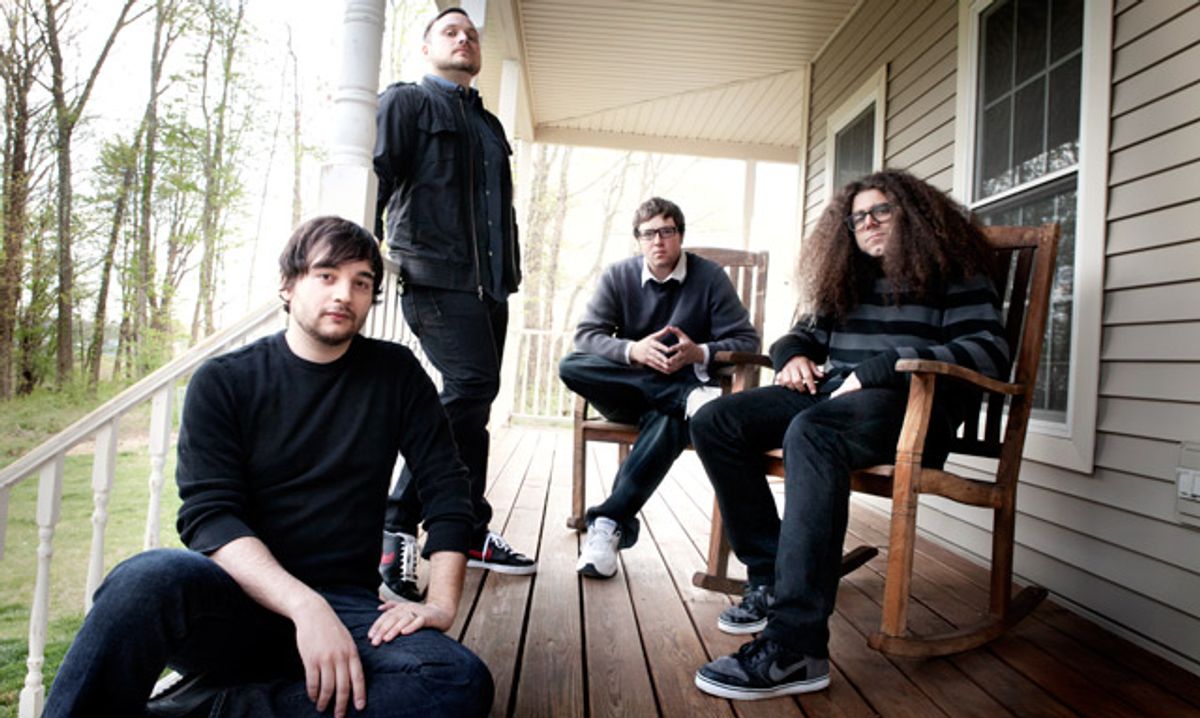Since the band’s formation in 1995, Coheed and Cambria has put out prog-rock concept albums so epic that there’s a Facebook page called “The Word ‘Epic’ should only be
Since the band’s formation in 1995, Coheed and Cambria has put out prog-rock concept albums so epic that there’s a Facebook page called “The Word ‘Epic’ should only be used when applied to Coheed and Cambria.” The albums are all tied in to frontman Claudio Sanchez’s The Amory Wars comics (of which there is a full-length feature movie in the works, to be produced by Mark Wahlberg and Stephen Levinson), and they take the listener on a mythological sci-fi journey—sort of like Dungeons & Dragons for the iPod set. The group is calling its latest effort a double album, although the discs—The Afterman: Ascension and The Afterman: Descension—are to be released separately (Ascension comes out October 9, and Descension will be released in February).
As you’d expect from something this majestic, much drama ensued during the nearly two years it took to make the discs. Bassist Michael Todd, who was with the band early on, had previously left in 2006 to enter rehab for heroin addiction. He was temporarily replaced by Matt Williams but rejoined in 2007. His troubles were not behind, however, and in July 2011 Todd was arrested for holding up a Walgreens in Massachusetts, demanding Oxycontin while claiming he had a bomb. He escaped via taxi but was caught by police at the Comcast Center just as the band was getting ready to open for Soundgarden. Todd was diagnosed with cancer earlier this year, so Zach Cooper is currently on bass duties. But Todd wasn’t the only Coheed casualty. Drummer Chris Pennie, a founding member of the Dillinger Escape Plan who joined Coheed and Cambria in 2007, also battled a serious drug problem and left the band in November 2011, just weeks after the new album plans were announced. He was replaced with returning member Josh Eppard, who originally played with the band from 2000–2006.
In spite of a tumultuous path to fruition, the self-financed albums emerged from the abyss. For hardcore fans, the limited deluxe box set of the 19-song albums includes a 78-page hardcover Afterman coffee-table book and a nearly two-hour documentary DVD. Coheed and Cambria guitarist Travis Stever tells us about the making of the albums and how personnel changes brought new life to the band.
The Afterman is the product of nearly two years of writing. Was it a blessing or a curse to have this much time?
It’s been a long process and it feels too long, but it was a very productive time. I think it was a blessing that we were able to take our time.
Were the new songs written specifically for The Afterman, or had they been around for a while?
A lot of the songs had been around for quite some time, even before Josh [Eppard] rejoined. I remember there were a couple of songs that Claudio had demoed out a long time ago.
Did you have to resist the temptation to change things? At some point you have to draw the line, right?
Absolutely. But one of the best parts of this record is that, since we had no time restraints, we didn’t have to feel the pressure of “Aww, we have to draw the line here.” We could put something away for a minute and then move on to another thing, then come back to it.
How do you know when it’s time to let go?
My theory is that if you draw the line, then it was not meant to be in the first place. If you overdid it and you had to draw the line, then quite possibly you’re not working on the right part altogether.

Personnel changes seem to plague the band. In 2006, when Mike Todd’s drug problems became too much, he was replaced by Matt Williams. This time around you have Zach Cooper on bass. How did this affect the band?
Matt was with us for quite some time and is an amazing player. We had a blast. That was one of those scenarios where you realize that if you’re going to get a friend involved, you have to start it from the beginning. You can’t have this machine that’s rolling so heavily and then get someone that you really care about involved. It’s going to be hard for them to understand that it’s a whole different world. He came in at one of the most difficult times for the band.
And then, yet again, Zach came into a difficult scenario, too. We’re kind of left with the same thing but I think that this time, the chemistry that’s built between the excitement of Zach and feeling like, “This is a person that we would hang out with anyway.” Also, with Josh, in a way, it’s almost like we’re relieved to be back as well as excited—it almost gives us new life.
Were you midway through the making of The Afterman when that armed robbery incident happened with Michael Todd?
No, that’s the misconception. He wasn’t on any of those songs—the songs were so young at that point that there was no involvement yet. As it goes with Coheed and Cambria, a lot of times the bass is the last thing to be done. A lot of this material was worked out with the unit that we are now, whether it be something that Claudio demoed and then we worked out at Applehead [Studios] as a band, or Claudio might have had them already and maybe I put some guitars to them.
Are the clean, staccato single-note parts in “The Afterman” and “Key Entity Extraction IV Evagria the Faithful” picked or played using an Edge-type delay setting?
I know what you’re talking about [Sings repeating delay-type figure]—there’s a similar sound, and there is definitely delay on it, but it’s all picked. Everything you’re hearing, I’m picking. A lot of it is the staccato kind of jumping around.
What are you using for that gnarly fuzz tone on “Key Entity Extraction II Hollywood the Cracked?”
I don’t know if you remember Bleach, the record by Nirvana, but we were trying to go for something like that. Trying to get that sound. I don’t remember exactly what we used. It might have been just a heavy fuzz like a Big Muff or maybe I used the Bogner Uberschall that Claudio was using.
Speaking of taking our time with the record, what’s going to be tough is that I think I did the guitar parts for “Hollywood” probably about a year ago, by now. So it’s like, “Holy shit, I don’t remember,” and I’m going to have to recreate it live. And Claudio is also going to have to, although he’s a little more organized. He might have actually written down what he used.
What other effects are essential to your sound?
I don’t use the Big Muff live, but I think it was used a couple of times in the studio for certain parts. I think there was a song where I even used a Fender Blender at one point. I used a Fender Blender on Year of the Black Rainbow, and I used it live back then, too.
Why don’t you use the Blender live anymore?
What I found is that using certain pedals live that I used in the studio, sometimes it gets lost in translation. Sometimes I will stick to the exact gear—I’ll go back and listen to it and be like, “All right, I know exactly what I need to recreate this.” But sometimes in the live setting it could use some smoothing out. You know, at the time we had been using Axe-Fxs [straight to the P.A., with no onstage amps or cabinets], but we might be going back to a live rig [with onstage amps].
Travis Stever’s Gear
Guitars
2002 teal Gibson SG, 1998 tobacco-burst Gibson Les Paul, 2010 goldtop Gibson Les Paul with Bigsby, 2010 Gibson Custom Les Paul Black Beauty, 2004 wine red Gibson Les Paul with Bigsby, 2008 Gibson Johnny A
Amps
Atomic 12” self-powered speaker, Mesa/Boogie Mark Five 4x12 straight-front cab
Effects
Fractal Audio Axe-Fx Ultra, Electro-Harmonix Big Muff, Fender Blender, Ernie Ball volume pedal, Rocktron Banshee 2 Talkbox, Mission Engineering expression pedal
Strings, Picks, and Accessories
DR .010–.046 strings, Dunlop Nylon black 1 mm picks, Audio-Technica AEW-R5200 wireless system, Voodoo Lab Ground Control, Boss TU-2 Tuner, Whirlwind Multi-Selector
Why?
With the Axe-Fx, one thing I’ve found that can be a hurdle is that I am a person who loves getting sustain and utilizing feedback, like I did in the beginning of “In Keeping Secrets.” Everybody always thought that was done using an EBow but it was just me utilizing feedback. That’s always something that I’ve been in love with and if I can’t get that … . We figured out a way to get around that hurdle and get some good sounds out of it, but that’s something that I definitely missed. But the Axe-Fx has been very, very useful. To be honest, we actually use the Axe-Fx for demoing, too. We also used it for a couple of clean sounds on the record. It sounded so good for that.
The Axe-Fx is pretty complex, too. Did it take a while for you to tweak it to your liking?
We have guitar techs that have been working with us and there has been really great communication. We’ll stand there, they’ll press the buttons, and I’ll just keep playing. I’ll be like, “That’s it!” Or I’ll ask, “Can you get this sound?” and I’ll describe it.
What was your main amp prior to the Axe-Fx, and do you think you’ll go back to that for your live rig?
When I was using amps, I used a Mesa/Boogie Mark Five, and if I go back to a live rig, yes, I will go back to it.
Between your goldtop Les Paul and your Black Beauty, you’re obviously a big Les Paul fanatic. What draws you to them?
You know what, I started as a kid thinking Les Pauls were the best because I loved Jimmy Page and Ace Frehley. Also, one of my favorite guitar players was Mick Ronson, so I wanted to get that goldtop. But as I grew up, I realized that it actually is my favorite guitar—it wasn’t just because I thought those guys were cool. It’s the nicest sounding guitar that I’ve ever had.
YouTube It
For a taste of Coheed and Cambria’s epic live performances, check out the following clips on YouTube.com.
Coheed and Cambria tear it up with their hit “Welcome Home” at the 2006 Live at Leeds festival.
Coheed and Cambria perform a quieter, but no less powerful, acoustic twist on their signature song “Welcome Home.”
Enjoy the full Coheed experience with this entire concert from the Starland Ballroom.


